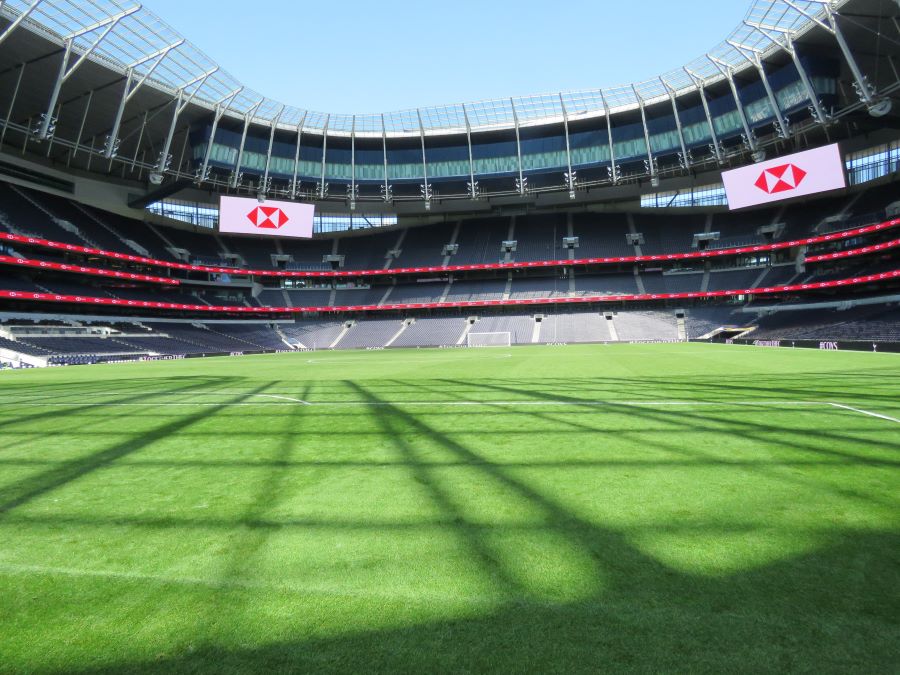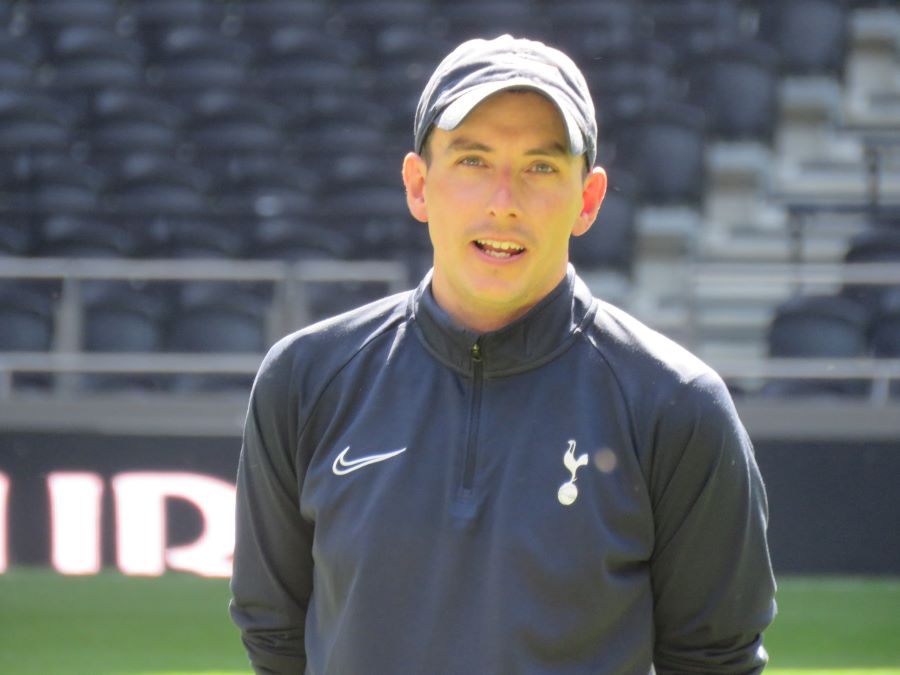- Homepage
- News and Features
- Down Hotspur Way
Down Hotspur Way
The team at Tottenham Hotspur produce one of the world’s most innovative playing surfaces, using age-old techniques and the latest technology.

What can a golf club learn from a multi-billion-pound Premier League stadium?
Earlier this year, Greenkeeper International joined volunteers from BIGGA’s South East Region as they were given a behind-the-scenes look at the world’s most ambitious natural playing surface.
Wayne Billing is grounds manager at Tottenham Hotspur Stadium and is responsible for a football pitch that is redefining what can be achieved in the sports turf industry.
“The stadium is unique, so you could never be taught what we have learnt in the four years that we’ve been here,” said Wayne, whose team was named Premier League Grounds Team of the Season for 2021/22. “It’s constantly evolving and this is new technology that we are pioneering.”
As the World Cup gets underway in Qatar this month, the work will continue for the UK’s Premier League groundsmen. It’s unlikely that any of them will be undertaking a project on the scale of the Tottenham Hotspur Stadium team, though, as they set about installing a new American football pitch underneath the grass playing surface.
The stadium is the largest Premier League ground in London and the second largest in the UK, with a capacity of 62,850. It includes Europe’s largest single tier stand, with 17,605 seats, but behind the seats there’s also an on-site micro-brewery, Europe’s longest drinks bar and the most innovative pitch construction you’ve ever seen. It is a living Premier League-standard playing surface that can be removed from the stadium and stored in a car park, where it is kept in near-pristine condition until needed. And, frankly, it has to be seen to be believed.
The pitch is the first hybrid carpet pitch in the Premier League and comprises of a Desso Playmaster carpet system that has interwoven polyethylene plastic fibres to aid stability, player traction and performance.
Each year in early March, 9,600m2 of turf is laid by Hewitt’s Sportsturf and Tiller’s Turf in Lincolnshire. Under the supervision of Wayne and his team, the pitch is grown for around 12 to 16 weeks before being transported to the stadium as 735 individual rolls that are installed over three days. This season, the turf was laid just two days before a match was due to take place.
“That’s a tight turnaround from our perspective,” said Wayne. “But it’s due to the business model of the stadium to try and generate maximum revenue. While a regular renovation can take six weeks, we can have a concert one week and a Premier League game the next weekend. It’s pretty challenging from a groundsperson’s perspective, but it is rewarding when it all comes together.”

Looking at in profile, the surface is 40-45mm of hybrid turf comprising 100% ryegrass. Below that is 125mm upper rootzone above 175mm lower rootzone. There are then undersoil heating pipes at 300mm intervals and a 150mm permavoid crate above a waterproof membrane.
This membrane protects a 63mm turf nation synthetic carpet, which is the NFL-grade playing surface used for two American football games each year. That sits above a sand and black SBR infill layer, a 17mm Mondo shock pad, a layer of open texture tarmac, an 85mm permavoid crate and then a concrete slab.
You have to believe that at some point, much of this technology will filter down into other levels of the game and even into other sports. But until that happens, Wayne said Tottenham Hotspur Stadium can be used for another, inspiring purpose.
“We should be using these types of venues to attract kids to the industry,” he said. “If you brought kids here, what is not to love? I would find it hard to believe you wouldn’t instantly be drawn into wanting to learn more.
“We put together a brainstorm of what the 21st Century groundsperson does. We’re struggling to attract people into the industry, but we’re not really telling them what the role is. The perception is we just cut the grass, but until we get that information out there and get the kids to this type of venue to see what we actually, do, you’re never going to achieve anything. There are so many people who are passionate about what we’re doing, but as an industry we don’t engage with an audience.”
And it is easy to see why Wayne and the team would be so inspired by their working environment. Come matchday, with the Champions League anthem ringing out around the stadium, having prepared the most incredible playing surface using traditional expertise combined with the latest technology, it must be an incredible feeling.
The Tottenham team are better than many at giving an insight into the creation of a modern football pitch, due in part to the tremendous publicity the new stadium garnered. But come matchday, most of the hard work is – by necessity – hidden from view. For example, when you step out onto the pitch, those massive stands are breathtaking, but they also rob the pitch of any natural light. Even in mid-summer, less than 40% of the pitch is exposed to natural light, making the stadium one of the shadiest in Europe, and so the grounds team supplements the turf with the world’s first fully integrated grow light system. Each grow light weighs 20 tonnes and spans the full 70m width of the field, but nothing actually touches the turf. The pitch is also divided into 36 areas and the 864 lights can be adjusted to ensure all 7,525m2 of pitch receives the appropriate level of light. In total, approximately 1,000,000 mmol/s of light are applied by the SGL system each year (the sun produces 1,700 mmol/s/sqm on a clear summer’s day).
“For five months of the year, we’re essentially in darkness in the bowl, so we’re not getting any natural light whatsoever,” said Wayne. “[If there wasn’t any artificial lighting] we wouldn’t have much grass left. If you go back 20 years to when we didn’t have artificial lighting, there wasn’t much grass kicking around at all on football pitches.”
You can watch a video of the lighting in action here: https://youtu.be/nHhmbRsdNfA
There are other challenges presented by the microclimate of a massive stadium. Even though the grass is ‘outside’, the lack of wind can cause stagnant air and reduce evapotranspiration, leading to severe disease pressures.
Wayne said: “The disease pressure inside the bowl is huge. As soon as you irrigate you’re into a whole world of pain if you get it wrong, so we always err on the side of caution.”
The pitch is constantly monitored, with PitchCam offering a livestream of the pitch and daily quality scans of the entire surface using GrassFocus, a camera system that can identify problems four or five days in advance of what can be seen by the human eye.
There is an integrated preventative turf disease programme and UV-C light treatment can prevent fungal diseases by killing bacteria and other pathogens.
All this is simple, though, compared to the challenge of managing the turf and preventing diseases when the pitch is in storage, which it can be for more than two weeks at a time.
In advance of being placed into storage, the team will undertake a full IPM programme and apply preventative fungicides. At that point the clock is ticking because the efficacy of products will drastically reduce after 14 days. Inputs such as fertilisers are reduced and plant growth regulators are applied. The height of cut is reduced from 23-25mm to 17mm and the pitch is heavily irrigated.
There are 150 tasks to tick off before the pitch can be moved, but when it does, the turf splits into three and its holding trays are revealed. Weighing a combined 10,000 tonnes, the pitch runs on 594 wheels over 2km of steel rail and is moved by 112 hydraulic cylinders.
When in storage, there is 1.3m of clearance between the pitch and the car park roof so mowing can continue, although products cannot be applied. The temperature is kept at 6-8°C and two dehumidification units help prevent disease and minimise leaf wetness while keeping the turf as close to dormant as possible – although etiolated growth will begin to occur after two weeks. There’s also the world’s largest indoor stadium LED system, helping keep the plant healthy but without creating additional heat.

The entire process of transitioning from a football pitch to an NFL pitch takes about 54 hours at present, and you can watch a video of it on YouTube here: https://youtu.be/o9kDe1eOn64
“It’s a full-time job to manage the pitch while it’s in storage,” said Wayne. “You’ve got 1.3m headroom across the surface, so we do hand readings and our own reports to make sure the turf quality isn’t dropping.
“My job is purely data gathering, analysing process and working out logistics and I enjoy the challenge. When we came to the stadium a lot of people, even industry experts, said we would fail and wouldn’t be able to deliver it, but we have just won pitch of the year.”
In the 2021/22 calendar the stadium hosted 19 Premier League games, two NFL matches, a major boxing event, three Women’s Super League games, four Champions League matches, a Betfred Challenge Cup match, three Carabao Cup matches, two FA Cup matches, one Gallagher Premiership Rugby match and nine live music concerts, in addition to first team training, U23s matches and corporate events.
Whether on the artificial turf or the natural playing surface that Tottenham Hotspur’s players enjoy, the enjoyment for Wayne and his team is the same as any other groundsman or greenkeeper and comes from providing the stage upon which exciting things will happen.
During a match, Wayne will be stood in the tunnel in case an urgent situation arises, but he gets the goosebumps the same as any other when, for example, the Champions League anthem begins to play.
“That’s the biggest buzz,” he said. “The buzz for us is delivering the event, not the event itself. The reward of hosting a successful event with everyone coming in happy afterwards and saying the pitch looks good, that’s the name of the game.”
Author

Karl Hansell
Karl has been head of communications for BIGGA since March 2016. His duties include editing the monthly Greenkeeper International magazine, in addition to other communications activities for the association.
